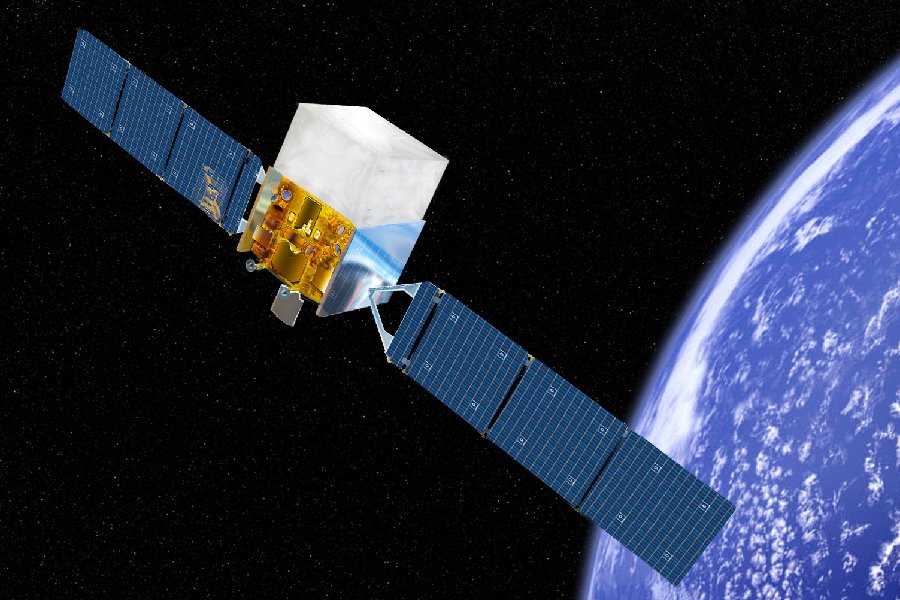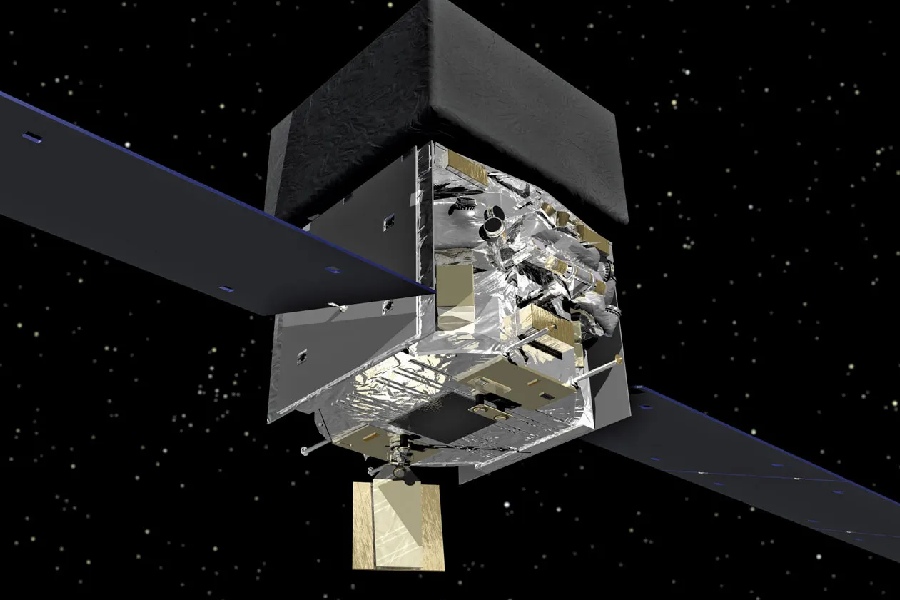A powerful NASA observatory orbits Earth silently, its sight fixated outwards, detecting extreme bursts of energy unlike anything human eyes can perceive. The Fermi Gamma ray Space Telescope operates beyond the visible light that human eyes can perceive.
It detects invisible yet violently energetic events unfolding across the cosmos. But what type of telescope is the Fermi Gamma-ray Space Telescope? Where is the Fermi Gamma ray Space Telescope located?
Fermi has revolutionized our understanding of black holes and the most chaotic and explosive processes commanding the cosmos. So, we will explore the mission, specialized instruments, remarkable telescope discoveries, and much more!

Fermi Gamma ray Space Telescope
The Fermi Gamma-ray Space Telescope, launched in 2008 by NASA, observes the universe in gamma rays. Named after physicist Enrico Fermi, it utilizes the Large Area Telescope for broad energy range gamma-ray detection and the Gamma-ray Burst Monitor for transient events. It is located in low Earth orbit, approximately 550 km (about 342 mi) above the Earth’s surface.
So, contributing to astrophysics and particle physics, Fermi enhances our understanding of high-energy phenomena. This includes pulsars, blazars, and gamma-ray bursts.
Purpose of the Fermi Gamma ray Space Telescope
It surveys the sky, monitoring gamma-ray sources. Fermi answers fundamental questions on cosmic high-energy phenomena and particle acceleration across the universe.
Objectives and mission
Fermi’s primary science goals involve understanding gamma-ray sources. For example, spinning pulsars, solar flares, exploding stars, and supermassive black holes.
It images the entire sky every three hours in the highest frequency electromagnetic rays, seeking clues into extreme physics. Fermi also traces cosmic ray origins and tests theories like quantum gravity.
Scientific significance
Studying the highest-energy explosions gives insight into nature’s most chaotic and violent processes. By spotting short-lived gamma-ray bursts, Fermi sends alerts, enabling other telescopes to observe these events rapidly.
This allows astronomers to accelerate advances by linking gamma-ray bursts to star-forming galaxies. Such gamma-ray observations from Fermi support formulating cutting-edge astrophysics theories from revolutionary perspectives.
Overview of the Telescope
The Fermi Gamma ray Space Telescope was launched in 2008 as an international astrophysics mission to enhance understanding of high-energy phenomena across the cosmos. It utilizes specialized detectors sensitive to the highest frequency electromagnetic waves—gamma rays—emitted by extremely energetic processes.
Launch and orbital deployment
Fermi lifted off aboard a Delta II rocket from Cape Canaveral on June 11, 2008. After a smooth launch, Fermi entered a near-circular orbit around Earth at an altitude of 565 km (351 mi) and an inclination of 25.6 degrees.
This specialized orbit allows Fermi’s Large Area Telescope to scan and image the sky every three hours without obstruction. After weeks of activation and calibration, the telescope started full science operations in August 2008.
Mission history and discoveries
Fermi has proven itself a prolific powerhouse as one of NASA’s flagship Great Observatories. As of 2023, it has operated over three times its five-year prime mission goal, providing 15 years of productive gamma-ray observations.
Key discoveries enabled by Fermi include mapping out the Milky Way’s gamma-ray emissions to trace cosmic rays. It includes catching flickering pulsars switching on and off unpredictably across the galaxy. Fermi also enabled amassing robust data on over 5,000 gamma-ray bursts plus other high-energy transients.
Based on its continued scientific bounty, the Fermi mission received multiple extensions beyond its original mandate. The telescope was granted indefinitely extended operations in 2018 to continue its valuable work surveying extreme gamma-ray sources across the universe.
Design and Construction
Precision engineering equips Fermi’s large detectors, mirrors, solar panels, and cooling system to fulfill its mission. It involves observing statistically rare but scientifically momentous high-energy events across galaxies.

Custom observatory architecture
Fermi’s specialized anatomy centers around a primary dish structure on the top deck holding the main Large Area Telescope (LAT) and secondary Gamma-ray Burst Monitor (GBM) instrument components. These are aligned toward space shielded by a surrounding anti-coincidence detector metal frame.
Additional support structures house stabilized crystal scintillators. These scintillators are positioned along stacked, mirrored channels optimally angled to further ferry gamma-ray signals toward the sensor planes.
Moreover, exterior features include star trackers for precision pointing knowledge and communication antennas to relay data continuously to Earth. Additionally, there is a sophisticated thermal control system that dissipates internal heat externally.
Pioneering technological feats
As its most sensitive gamma-ray observatory, Fermi pioneered several technological firsts to fulfill its complex mission. This includes demonstrating advanced data compression algorithms capable of rapidly transmitting large science data volumes from orbit to maximize product outputs.
It also showcased the superior sensitivity of modern gamma-ray detection approaches. These modern approaches convert particles into scintillating crystals relative to preceding observational methods.
Furthermore, Fermi has a high degree of autonomous precision pointing and calibration capabilities. These capabilities reflect software innovations modeling complex orbital gravitational dynamics – innovations evolved from lessons over prior space science missions.
Primary Instrument
A specialized Large Area Telescope (LAT) instrument is at the heart of Fermi’s scientific bounty. This instrument detects gamma rays with unprecedented resolution across a wide energy range–providing transformative new data streams shedding light on high-energy celestial events.
Large Area Telescope (LAT)
The LAT meticulously tracks cosmic gamma rays utilizing a grid of tungsten plates. These plates convert light particles into electron-positron pair emissions traced within a cesium-iodide crystal calorimeter block.
The LAT can reconstruct the source direction and energy level of incident gamma rays. It does this by tracking the rays’ interactions and paths as they pass through the instrument’s fine-grained detector planes. This can cover a large surface area. Then, state-of-the-art image reconstruction software transforms huge data flows into revealing gamma-ray event maps further studied.
Expanding Frontiers of Discovery
Beyond cataloging multitudes of gamma-ray sources, Fermi tackles cutting-edge studies. These studies span exotic searches for dark matter signals to probing extreme cosmic accelerators spawning the highest-energy particles ever detected.
Dark matter – An elusive quarry
Though dark matter particle interactions remain unseen, some leading theories predict these elusive particles could annihilate and decay into Standard Model byproducts. This includes positrons, electrons, protons, antiprotons, and photons across the electromagnetic spectrum – with a notable gamma-ray signature.
Fermi actively drives such work, surveying galaxies, galaxy clusters, and cosmic voids across epochs. It seeks unexplained gamma-ray emissions potentially linked to fundamental dark matter dynamics. By stacking multiple observations, it tries to boost faint initial signals from these invisible giants pervading the universe.
Charged particles and cosmic accelerators
Fermi also traces ultra-energetic cosmic ray acceleration sites. These sites are tied to the most chaotic high-energy cataclysms the universe harbors. Some examples include the magnetospheres of pulsars, explosions of massive stars, and hot matter spiraling into stellar remnants.
Mapping and timing gamma-ray glows enable the assembling of light curves and multi-wavelength profiles. These profiles reveal key details on these exotic accelerator engines’ particle acceleration and energy gain mechanisms, including shocks and magnetic reconnection.
Additionally, this work produced the first complete all-sky image showing the structure of the Milky Way’s magnetic field influencing charged cosmic ray trajectories. The image was based on subtle gamma-ray signal variations.
Conclusion
As we wrap up our exploration of the Fermi Gamma ray Space Telescope, we aim to leave readers with a sense of enlightenment about its significant contributions to understanding high-energy cosmic phenomena. Fermi goes beyond counting cosmic accelerators; it employs advanced technology to reveal intense particle events in space.
This article has delved into Fermi’s intricate tools and major discoveries to help readers better comprehend how it spearheads new phases in astrophysics. With its unique and expansive view of gamma rays, the telescope is crucial in studying cosmic rays.
We hope readers now deeply appreciate Fermi’s impact on advancing our understanding of the cosmos.
